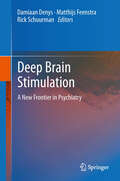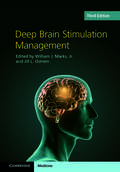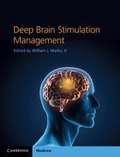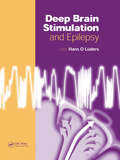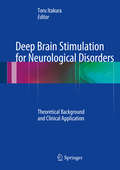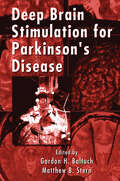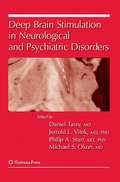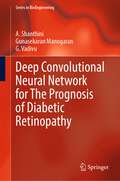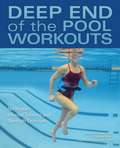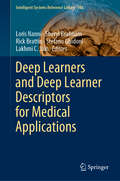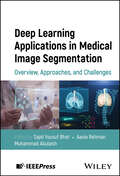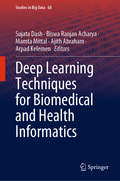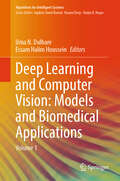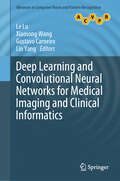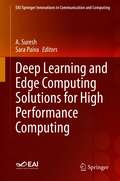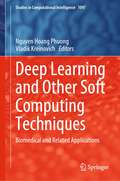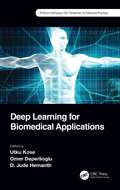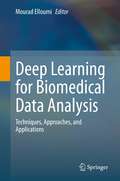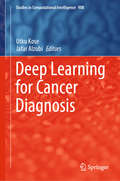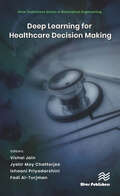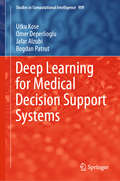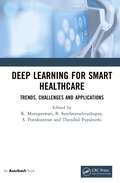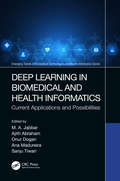- Table View
- List View
Deep Brain Stimulation
by Rick Schuurman Matthijs Feenstra Damiaan DenysDeep Brain Stimulation: A New Frontier in Psychiatry provides an overview of current developments and the future possibilities of deep brain stimulation for patients with therapy-refractory psychiatric disorders. The side-by-side presentation of clinical applications and animal research provides a truly translational approach. Also included is a special chapter on the ethical issues involved in deep brain stimulation in psychiatry. Deep brain stimulation of selected brain areas has been shown to result in a substantial improvement of symptoms and quality of life in patients suffering from obsessive-compulsive disorder, major depressive disorder and drug addiction. Although it is still an experimental therapy and the number of psychiatric patients that are treated is low, its effectiveness and safety makes deep brain stimulation the most promising therapy for treating other serious and life-threatening psychiatric conditions.
Deep Brain Stimulation Management
by William J. Marks Jr. Jill L. OstremDeep brain stimulation (DBS) is now a firmly established treatment for movement disorders, and an increasing body of evidence supports DBS in the treatment of other neurological and psychiatric disorders. This essential reference guide outlines a practical approach to the use of this paradigm-shifting therapy and covers key aspects of DBS practice. Chapters describe how to implement a DBS program and select appropriate patients, device programming to achieve optimal symptom control, and long-term management of patients. Thoroughly revised, this third edition includes additional chapters on managing patients with emerging applications of DBS. An entire chapter is dedicated to troubleshooting common problems with the therapy as many 'failures' are preventable and addressable. With contributions from experts in the field, this is a must-have reference guide for any clinician working with DBS patients.
Deep Brain Stimulation Management
by William J. Marks Jr."Deep Brain Stimulation Management is a practical guide to the use of this paradigm-shifting therapy for movement disorders, including Parkinson's disease, essential tremor, and dystonia. This title is an essential resource for clinicians who wish to begin utilizing DBS, as well as current practitioners seeking to improve their understanding and application of the technique. Highly illustrated and in full color throughout, this comprehensive book covers the key aspects of DBS practice, including patient selection, device programming and activation to achieve optimum symptom control, long-term management, and troubleshooting. With contributions from some of the most experienced clinical leaders in the field of DBS and extremely practical content, this is an essential reference text for any clinician working with DBS patients"--Provided by publisher.
Deep Brain Stimulation Management
by William J. Marks Jr.This concise guide to deep brain stimulation (DBS) outlines a practical approach to the use of this paradigm-shifting therapy for neurologic and psychiatric disorders. Fully revised throughout, the new edition provides extensive information about the application of DBS to movement disorders, and includes new chapters on DBS to treat epilepsy and psychiatric conditions. With the evolution of surgical techniques for DBS lead implantation, a brand new section focused on interventional MRI approaches is also included. All key aspects of DBS practice are covered, including patient selection, device programming to achieve optimal symptom control, long-term management, and trouble-shooting. It is a guide to be kept in the clinic and consulted in the course of managing patients being considered for, or treated with, DBS. With contributions from some of the most experienced clinical leaders in the field, this is a must-have reference guide for any clinician working with DBS patients.
Deep Brain Stimulation and Epilepsy
by Hans O. LüdersDeep brain stimulation has been used effectively for many years to treat patients suffering from Parkinson's disease. Now, neurologists and neurosurgeons are using electric pulse generators to block abnormal activity, i.e. epileptic fits. Promising research results indicate that electric pulses implanted deep in the brain can affect neurocircuitry and help stop oncoming seizures. Supplying a solid background on brain stimulation and its application to epilepsy, Deep Brain Stimulation and Epilepsy provides a historical overview, explores pathogenesis of brain stimulation, discusses animal experiments and human studies, and explores future prospects of brain stimulation for epileptic control. The editor and his team of contributors distill information drawn directly from the literature into one convenient resource.
Deep Brain Stimulation for Neurological Disorders
by Toru ItakuraChronic electrical stimulation of the brain has demonstrated excellent outcomes in patients with Parkinson's disease and has recently also been applied to various other neurological diseases. This comprehensive, up-to-date textbook will meet the needs of all who wish to learn more about the application of deep brain stimulation and will provide a sound basis for safe and accurate surgery. The book comprises two main parts, the first of which presents relevant anatomical and functional background information on the basal ganglia, thalamus and other brain structures as well as on the mechanism of brain stimulation. The second part describes clinical studies on deep brain stimulation, covering results in a range of movement disorders and psychiatric diseases and also important aspects of instrumentation and technique. The authors are outstanding scientists and experts in the field from across the world.
Deep Brain Stimulation for Parkinson's Disease (Neurological Disease and Therapy)
by Gordon H. Baltuch Matthew B. SternConsidered the largest breakthrough in the treatment of Parkinson's disease in the past 40 years, Deep Brain Stimulation (DBS) is a pioneering procedure of neurology and functional neurosurgery, forging enormous change and growth within the field. The first comprehensive text devoted to this surgical therapy, Deep Brain Stimulation for Parkinson's
Deep Brain Stimulation in Neurological and Psychiatric Disorders
by Daniel Tarsy Philip Starr Michael Okun Jerrold Lee VitekThis important book discusses today's most current and cutting-edge applications of Deep Brain Stimulation (DBS). The book begins with reviews of the functional anatomy and physiology of motor and nonmotor aspects of the basal ganglia and their connections which underlie the application of DBS to neurological and psychiatric disorders. This is followed by proposed mechanisms of action of DBS based on functional neuroimaging and neurophysiologic studies in animals and man.
Deep Convolutional Neural Network for The Prognosis of Diabetic Retinopathy (Series in BioEngineering)
by G. Vadivu Gunasekaran Manogaran A. ShanthiniThis book discusses a detailed overview of diabetic retinopathy, symptoms, causes, and screening methodologies. Using a deep convolution neural network and visualizations techniques, this work develops a prognosis system used to automatically detect the diabetic retinopathy disease from captured retina images and help improve the prediction rate of diagnosis. This book gives the readers an understanding of the diabetic retinopathy disease and recognition process that helps to improve the clinical analysis efficiency. It caters to general ophthalmologists and optometrists, diabetologists, and internists who encounter diabetic patients and most prevalent retinal diseases daily.
Deep End of the Pool Workouts: No-Impact Interval Training and Strength Exercises
by Melisenda Edwards Katalin WightA guide to the hottest new trend in full-body, no-impact exercise—pool workouts where your feet never touch the bottomWhether you&’re a professional athlete or general fitness enthusiast, wouldn&’t you prefer a workout that&’s kinder to your joints while also producing amazing results? Thanks to the higher force required to move your body against water&’s resistance and the absence of any impact during the exercises, the workouts in this book do just that.By detailing proper form and technique, this handy guide makes sure you gain maximum benefit from your water workout, including greater: • SPEED• POWER• STRENGTH• FLEXIBILITY
Deep Learners and Deep Learner Descriptors for Medical Applications (Intelligent Systems Reference Library #186)
by Lakhmi C. Jain Sheryl Brahnam Loris Nanni Stefano Ghidoni Rick BrattinThis book introduces readers to the current trends in using deep learners and deep learner descriptors for medical applications. It reviews the recent literature and presents a variety of medical image and sound applications to illustrate the five major ways deep learners can be utilized: 1) by training a deep learner from scratch (chapters provide tips for handling imbalances and other problems with the medical data); 2) by implementing transfer learning from a pre-trained deep learner and extracting deep features for different CNN layers that can be fed into simpler classifiers, such as the support vector machine; 3) by fine-tuning one or more pre-trained deep learners on an unrelated dataset so that they are able to identify novel medical datasets; 4) by fusing different deep learner architectures; and 5) by combining the above methods to generate a variety of more elaborate ensembles. This book is a value resource for anyone involved in engineering deep learners for medical applications as well as to those interested in learning more about the current techniques in this exciting field. A number of chapters provide source code that can be used to investigate topics further or to kick-start new projects.
Deep Learning Applications in Medical Image Segmentation: Overview, Approaches, and Challenges
by Sajid Yousuf Bhat Aasia Rehman Muhammad AbulaishApply revolutionary deep learning technology to the fast-growing field of medical image segmentation Precise medical image segmentation is rapidly becoming one of the most important tools in medical research, diagnosis, and treatment. The potential for deep learning, a technology which is already revolutionizing practice across hundreds of subfields, is immense. The prospect of using deep learning to address the traditional shortcomings of image segmentation demands close inspection and wide proliferation of relevant knowledge. Deep Learning Applications in Medical Image Segmentation meets this demand with a comprehensive introduction and its growing applications. Covering foundational concepts and its advanced techniques, it offers a one-stop resource for researchers and other readers looking for a detailed understanding of the topic. It is deeply engaged with the main challenges and recent advances in the field of deep-learning-based medical image segmentation. Readers will also find: Analysis of deep learning models, including FCN, UNet, SegNet, Dee Lab, and many moreDetailed discussion of medical image segmentation divided by area, incorporating all major organs and organ systemsRecent deep learning advancements in segmenting brain tumors, retinal vessels, and inner ear structuresAnalyzes the effectiveness of deep learning models in segmenting lung fields for respiratory disease diagnosisExplores the application and benefits of Generative Adversarial Networks (GANs) in enhancing medical image segmentationIdentifies and discusses the key challenges faced in medical image segmentation using deep learning techniquesProvides an overview of the latest advancements, applications, and future trends in deep learning for medical image analysis Deep Learning Applications in Medical Image Segmentation is ideal for academics and researchers working with medical image segmentation, as well as professionals in medical imaging, data science, and biomedical engineering.
Deep Learning Techniques for Biomedical and Health Informatics (Studies in Big Data #68)
by Ajith Abraham Mamta Mittal Sujata Dash Biswa Ranjan Acharya Arpad KelemenThis book presents a collection of state-of-the-art approaches for deep-learning-based biomedical and health-related applications. The aim of healthcare informatics is to ensure high-quality, efficient health care, and better treatment and quality of life by efficiently analyzing abundant biomedical and healthcare data, including patient data and electronic health records (EHRs), as well as lifestyle problems. In the past, it was common to have a domain expert to develop a model for biomedical or health care applications; however, recent advances in the representation of learning algorithms (deep learning techniques) make it possible to automatically recognize the patterns and represent the given data for the development of such model. This book allows new researchers and practitioners working in the field to quickly understand the best-performing methods. It also enables them to compare different approaches and carry forward their research in an important area that has a direct impact on improving the human life and health. It is intended for researchers, academics, industry professionals, and those at technical institutes and R&D organizations, as well as students working in the fields of machine learning, deep learning, biomedical engineering, health informatics, and related fields.
Deep Learning and Computer Vision: Volume 1 (Algorithms for Intelligent Systems)
by Uma N. Dulhare Essam Halim HousseinThis book takes a balanced approach between theoretical understanding and real time applications. All topics show how to explore, build, evaluate and optimize deep learning models with computer vision. Deep learning is integrated with computer vision to enhance the performance of image classification with localization, object detection, object recognition, object segmentation, image style transfer, image colorization, image reconstruction, image super-resolution, image synthesis, motion detection, pose estimation, semantic segmentation in biomedical field. Huge number of efficient approaches/applications and models support medical decisions in the fields of cardiology, dermatology, and radiology. The content of book elaborates deep learning models such as convolution neural networks, deep learning, generative adversarial network, long short-term memory networks (LSTM), autoencoder (AE), restricted Boltzmann machine (RBM), self-organizing map (SOM), deep belief network (DBN), etc.
Deep Learning and Computer Vision: Volume 2 (Algorithms for Intelligent Systems)
by Uma N. Dulhare Essam Halim HousseinThis book takes a balanced approach between theoretical understanding and real time applications. All topics show how to explore, build, evaluate and optimize deep learning models with computer vision. Deep learning is integrated with computer vision to enhance the performance of image classification with localization, object detection, object recognition, object segmentation, image style transfer, image colorization, image reconstruction, image super-resolution, image synthesis, motion detection, pose estimation, semantic segmentation in biomedical field. Huge number of efficient approaches/applications and models support medical decisions in the fields of cardiology, dermatology, and radiology. The content of book elaborates deep learning models such as convolution neural networks, deep learning, generative adversarial network, long short-term memory networks (LSTM), autoencoder (AE), restricted Boltzmann machine (RBM), self-organizing map (SOM), deep belief network (DBN), etc.
Deep Learning and Convolutional Neural Networks for Medical Imaging and Clinical Informatics (Advances in Computer Vision and Pattern Recognition)
by Gustavo Carneiro Le Lu Lin Yang Xiaosong WangThis book reviews the state of the art in deep learning approaches to high-performance robust disease detection, robust and accurate organ segmentation in medical image computing (radiological and pathological imaging modalities), and the construction and mining of large-scale radiology databases. It particularly focuses on the application of convolutional neural networks, and on recurrent neural networks like LSTM, using numerous practical examples to complement the theory. The book’s chief features are as follows: It highlights how deep neural networks can be used to address new questions and protocols, and to tackle current challenges in medical image computing; presents a comprehensive review of the latest research and literature; and describes a range of different methods that employ deep learning for object or landmark detection tasks in 2D and 3D medical imaging. In addition, the book examines a broad selection of techniques for semantic segmentation using deep learning principles in medical imaging; introduces a novel approach to text and image deep embedding for a large-scale chest x-ray image database; and discusses how deep learning relational graphs can be used to organize a sizable collection of radiology findings from real clinical practice, allowing semantic similarity-based retrieval.The intended reader of this edited book is a professional engineer, scientist or a graduate student who is able to comprehend general concepts of image processing, computer vision and medical image analysis. They can apply computer science and mathematical principles into problem solving practices. It may be necessary to have a certain level of familiarity with a number of more advanced subjects: image formation and enhancement, image understanding, visual recognition in medical applications, statistical learning, deep neural networks, structured prediction and image segmentation.
Deep Learning and Edge Computing Solutions for High Performance Computing: High Performance Computing And Emerging Healthcare Technologies (EAI/Springer Innovations in Communication and Computing)
by A. Suresh Sara PaivaThis book provides an insight into ways of inculcating the need for applying mobile edge data analytics in bioinformatics and medicine. The book is a comprehensive reference that provides an overview of the current state of medical treatments and systems and offers emerging solutions for a more personalized approach to the healthcare field. Topics include deep learning methods for applications in object detection and identification, object tracking, human action recognition, and cross-modal and multimodal data analysis. High performance computing systems for applications in healthcare are also discussed. The contributors also include information on microarray data analysis, sequence analysis, genomics based analytics, disease network analysis, and techniques for big data Analytics and health information technology.
Deep Learning and Other Soft Computing Techniques: Biomedical and Related Applications (Studies in Computational Intelligence #1097)
by Vladik Kreinovich Nguyen Hoang PhuongThis book focuses on the use of artificial intelligence (AI) and computational intelligence (CI) in medical and related applications. Applications include all aspects of medicine: from diagnostics (including analysis of medical images and medical data) to therapeutics (including drug design and radiotherapy) to epidemic- and pandemic-related public health policies.Corresponding techniques include machine learning (especially deep learning), techniques for processing expert knowledge (e.g., fuzzy techniques), and advanced techniques of applied mathematics (such as innovative probabilistic and graph-based techniques).The book also shows that these techniques can be used in many other applications areas, such as finance, transportation, physics. This book helps practitioners and researchers to learn more about AI and CI methods and their biomedical (and related) applications—and to further develop this important research direction.
Deep Learning for Biomedical Applications (Artificial Intelligence (AI): Elementary to Advanced Practices)
by D. Jude Hemanth Utku Kose Omer DeperliogluThis book is a detailed reference on biomedical applications using Deep Learning. Because Deep Learning is an important actor shaping the future of Artificial Intelligence, its specific and innovative solutions for both medical and biomedical are very critical. This book provides a recent view of research works on essential, and advanced topics. The book offers detailed information on the application of Deep Learning for solving biomedical problems. It focuses on different types of data (i.e. raw data, signal-time series, medical images) to enable readers to understand the effectiveness and the potential. It includes topics such as disease diagnosis, image processing perspectives, and even genomics. It takes the reader through different sides of Deep Learning oriented solutions. The specific and innovative solutions covered in this book for both medical and biomedical applications are critical to scientists, researchers, practitioners, professionals, and educations who are working in the context of the topics.
Deep Learning for Biomedical Data Analysis: Techniques, Approaches, and Applications
by Mourad ElloumiThis book is the first overview on Deep Learning (DL) for biomedical data analysis. It surveys the most recent techniques and approaches in this field, with both a broad coverage and enough depth to be of practical use to working professionals. This book offers enough fundamental and technical information on these techniques, approaches and the related problems without overcrowding the reader's head. It presents the results of the latest investigations in the field of DL for biomedical data analysis. The techniques and approaches presented in this book deal with the most important and/or the newest topics encountered in this field. They combine fundamental theory of Artificial Intelligence (AI), Machine Learning (ML) and DL with practical applications in Biology and Medicine. Certainly, the list of topics covered in this book is not exhaustive but these topics will shed light on the implications of the presented techniques and approaches on other topics in biomedical data analysis. The book finds a balance between theoretical and practical coverage of a wide range of issues in the field of biomedical data analysis, thanks to DL. The few published books on DL for biomedical data analysis either focus on specific topics or lack technical depth. The chapters presented in this book were selected for quality and relevance. The book also presents experiments that provide qualitative and quantitative overviews in the field of biomedical data analysis. The reader will require some familiarity with AI, ML and DL and will learn about techniques and approaches that deal with the most important and/or the newest topics encountered in the field of DL for biomedical data analysis. He/she will discover both the fundamentals behind DL techniques and approaches, and their applications on biomedical data. This book can also serve as a reference book for graduate courses in Bioinformatics, AI, ML and DL. The book aims not only at professional researchers and practitioners but also graduate students, senior undergraduate students and young researchers. This book will certainly show the way to new techniques and approaches to make new discoveries.
Deep Learning for Cancer Diagnosis (Studies in Computational Intelligence #908)
by Utku Kose Jafar AlzubiThis book explores various applications of deep learning to the diagnosis of cancer,while also outlining the future face of deep learning-assisted cancer diagnostics. As is commonly known, artificial intelligence has paved the way for countless new solutions in the field of medicine. In this context, deep learning is a recent and remarkable sub-field, which can effectively cope with huge amounts of data and deliver more accurate results. As a vital research area, medical diagnosis is among those in which deep learning-oriented solutions are often employed.Accordingly, the objective of this book is to highlight recent advanced applications of deep learning for diagnosing different types of cancer. The target audience includes scientists, experts, MSc and PhD students, postdocs, and anyone interested in the subjects discussed. The book can be used as a reference work to support courses on artificial intelligence, medical and biomedicaleducation.
Deep Learning for Healthcare Decision Making (River Publishers Series in Biomedical Engineering)
by Jyotir Moy Chatterjee Fadi Al-Turjman Vishal Jain Ishaani PriyadarshiniHealth care today is known to suffer from siloed and fragmented data, delayed clinical communications, and disparate workflow tools due to the lack of interoperability caused by vendor-locked health care systems, lack of trust among data holders, and security/privacy concerns regarding data sharing. The health information industry is ready for big leaps and bounds in terms of growth and advancement. This book is an attempt to unveil the hidden potential of the enormous amount of health information and technology. Throughout this book, we attempt to combine numerous compelling views, guidelines, and frameworks to enable personalized health care service options through the successful application of deep learning frameworks. The progress of the health-care sector will be incremental as it learns from associations between data over time through the application of suitable AI, deep net frameworks, and patterns. The major challenge health care is facing is the effective and accurate learning of unstructured clinical data through the application of precise algorithms. Incorrect input data leading to erroneous outputs with false positives is intolerable in healthcare as patients’ lives are at stake. This book is written with the intent to uncover the stakes and possibilities involved in realizing personalized health-care services through efficient and effective deep learning algorithms. The specific focus of this book will be on the application of deep learning in any area of health care, including clinical trials, telemedicine, health records management, etc.
Deep Learning for Medical Decision Support Systems (Studies in Computational Intelligence #909)
by Bogdan Patrut Utku Kose Omer Deperlioglu Jafar AlzubiThis book explores various applications of deep learning-oriented diagnosis leading to decision support, while also outlining the future face of medical decision support systems. Artificial intelligence has now become a ubiquitous aspect of modern life, and especially machine learning enjoysgreat popularity, since it offers techniques that are capable of learning from samples to solve newly encountered cases. Today, a recent form of machine learning, deep learning, is being widely used with large, complex quantities of data, because today’s problems require detailed analyses of more data. This is critical, especially in fields such as medicine. Accordingly, the objective of this book is to provide the essentials of and highlight recent applications of deep learning architectures for medical decision support systems. The target audience includes scientists, experts, MSc and PhD students, postdocs, and any readers interested in the subjectsdiscussed. The book canbe used as a reference work to support courses on artificial intelligence, machine/deep learning, medical and biomedicaleducation.
Deep Learning for Smart Healthcare: Trends, Challenges and Applications
by S. Poonkuntran B. Sundaravadivazhagan K. Murugeswari Thendral PuyalnithiDeep learning can provide more accurate results compared to machine learning. It uses layered algorithmic architecture to analyze data. It produces more accurate results since learning from previous results enhances its ability. The multi-layered nature of deep learning systems has the potential to classify subtle abnormalities in medical images, clustering patients with similar characteristics into risk-based cohorts, or highlighting relationships between symptoms and outcomes within vast quantities of unstructured data.Exploring this potential, Deep Learning for Smart Healthcare: Trends, Challenges and Applications is a reference work for researchers and academicians who are seeking new ways to apply deep learning algorithms in healthcare, including medical imaging and healthcare data analytics. It covers how deep learning can analyze a patient’s medical history efficiently to aid in recommending drugs and dosages. It discusses how deep learning can be applied to CT scans, MRI scans and ECGs to diagnose diseases. Other deep learning applications explored are extending the scope of patient record management, pain assessment, new drug design and managing the clinical trial process.Bringing together a wide range of research domains, this book can help to develop breakthrough applications for improving healthcare management and patient outcomes.
Deep Learning in Biomedical and Health Informatics: Current Applications and Possibilities (Emerging Trends in Biomedical Technologies and Health informatics)
by Ajith Abraham Ana Madureira M. A. Jabbar Sanju Tiwari Onur DoganThis book provides a proficient guide on the relationship between Artificial Intelligence (AI) and healthcare and how AI is changing all aspects of the healthcare industry. It also covers how deep learning will help in diagnosis and the prediction of disease spread. The editors present a comprehensive review of research applying deep learning in health informatics in the fields of medical imaging, electronic health records, genomics, and sensing, and highlights various challenges in applying deep learning in health care. This book also includes applications and case studies across all areas of AI in healthcare data. The editors also aim to provide new theories, techniques, developments, and applications of deep learning, and to solve emerging problems in healthcare and other domains. This book is intended for computer scientists, biomedical engineers, and healthcare professionals researching and developing deep learning techniques. In short, the volume : Discusses the relationship between AI and healthcare, and how AI is changing the health care industry. Considers uses of deep learning in diagnosis and prediction of disease spread. Presents a comprehensive review of research applying deep learning in health informatics across multiple fields. Highlights challenges in applying deep learning in the field. Promotes research in ddeep llearning application in understanding the biomedical process. Dr.. M.A. Jabbar is a professor and Head of the Department AI&ML, Vardhaman College of Engineering, Hyderabad, Telangana, India. Prof. (Dr.) Ajith Abraham is the Director of Machine Intelligence Research Labs (MIR Labs), Auburn, Washington, USA. Dr.. Onur Dogan is an assistant professor at İzmir Bakırçay University, Turkey. Prof. Dr. Ana Madureira is the Director of The Interdisciplinary Studies Research Center at Instituto Superior de Engenharia do Porto (ISEP), Portugal. Dr.. Sanju Tiwari is a senior researcher at Universidad Autonoma de Tamaulipas, Mexico.
